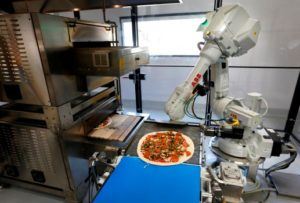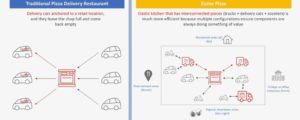Some Like it Hot: New Startup Can Deliver Your Pizza in 4 Minutes

How Zume Pizza is disrupting your favorite pizza delivery company
America’s Favorite Food
According to research conducted by the U.S. Department of Agriculture, pizza is America’s favorite food. From 2007 to 2010, researchers examined the diets of 17,571 study participants and determined that approximately “13% of the U.S. population aged 2 and over, consumed pizza on any given day.” [1] While food industry trends would suggest that the pizza industry will shrink as it loses share to healthier food categories, the $45 billion North American pizza industry is expected to grow 7.4% through 2020. [6].
Automating Pizza
Zume Pizza, a Silicon Valley startup founded in 2016, is committed to disrupting the supply chain of America’s favorite food through the use of robots and automation. In the beginning, the startup focused on highly-repetitive tasks that were low-skilled or dangerous. For example, the startup used its pizza-making robots to apply pizza sauces and place pizzas in an 800 degree oven. [7] According to the CEO, Julia Collins, the tech-enabled delivery-only company has become so efficient that it can create a pizza in 22 seconds [5]. Further, these efficiencies helped Zume deliver over 10,000 pizzas in the six months since its launch. [7] But the company did not stop there. In September 2016, Zume rolled out a pizza delivery van equipped with 56 ovens that allowed the company to cook pizzas while travelling to customers. [7] Since then, the company has raised over $48 million in funding, added a “Doughbot” designed to replace a dough spinner, and expanded geographically. [3]

Zume’s Supply Chain
The key to Zume’s business model is a decentralized pizza supply chain that allows the company to act more nimbly and take advantage of customer demand patterns. [3] Typically, pizzas are cooked in a brick-and-mortar retail location that delivery vehicles drive from to deliver pizzas to customers. Notably, these delivery vehicles will be empty once their deliveries are complete. Under the Zume model, the delivery vehicle is a relocatable kitchen that can be moved around based on projected demand. Zume is creating a world where your anchovy and strawberry pizza can be ordered and delivered in the four minutes before the start of Monday Night Football.

Challenges
Despite such innovation, challenges remain. Instead of the empty pizza vehicles being the bottleneck in the process, the central hub of robots is the bottleneck. [3] The only way to improve this is to increase the efficiency of the process through additional robots. These robots can cost up to $100,000 each on top of the cost of ownership for its vehicles. Under its asset-heavy financing model, the amount of money raised by Zume is a key constraint in its ability to scale. [2] In a highly competitive industry, where the top 50 pizza chains had nearly $25 billion of 2016 sales, Zume would largely be outmatched if the industry decided to emulate its automation best practices. [6] Notably, in August 2017, Domino’s and Ford announced a partnership to test self-driving delivery vehicles in Michigan. [4]
Further, Zume has to contend with critics who suggest that their disruption of the industry will take jobs away from low skilled workers. In the beginning, the startup needed six workers in its kitchen but now predicts that it will only need two – one for slicing and preparing toppings and the other for quality control. Collins believes that the key minimizing the impact of automation in the pizza industry is to retrain people for jobs that maximize their “talent.” [5] Notably, the company employs only full time workers and believes that automation will help provide access to high-quality, affordable meals. [8]
Looking Ahead
In a recent interview at Disrupt San Francisco, Collins suggested that Zume’s future is not focused on simply disrupting the pizza industry but rather disrupting the food industry à la Amazon and brick-and-mortar commerce. The Company chose pizza as a first step but will seek to automate more repetitive and dangerous food processes in the greater food industry.
Final Thoughts
Even though Zume Pizza has made significant progress in the digitization of the pizza supply chain, several questions remain:
- Does Zume Pizza taste good?
- Will Zume be able to capture significant market share from the dominant players in the pizza delivery industry?
- Will displaced workers be able to find the training necessary for higher-skilled, automation-proof jobs?
Word Count: 724
References
[1] Ars.usda.gov. (2017). Consumption of PizzaWhat We Eat in America, NHANES 2007-2010. Available at: https://www.ars.usda.gov/ARSUserFiles/80400530/ pdf/DBrief/11_consumption_of_pizza_0710.pdf [Accessed November 2017].
[2] Economist.com. (2017). Technology firms may struggle to disrupt the food business. Available at: https://www.economist.com/news/business-and-finance/21710766-zume-tries-reinvent-americas-34bn-pizza-business-one-robot-time-technology-firms-may [Accessed November 2017].
[3] Mannes, J. (2017). Zume Pizza adds extra automation as it rolls out to new cities. TechCrunch. Available at: https://techcrunch.com/2017/06/28/zume-pizza-adds-extra-automation-as-it-rolls-out-to-new-cities/ [Accessed November 2017].
[4] Media.ford.com. (2017). Domino’s and Ford Begin Consumer Research of Pizza Delivery Using Self-Driving Vehicles | Ford Media Center. Available at: https://media.ford.com/content/fordmedia/fna/us/en/news/2017/08/29/dominos-ford-begin-research-pizza-delivery.html [Accessed November 2017].
[5] Mercurynews.com. (2017). Zume Pizza: Mountain View startup uses robots, smart ovens. Available at: http://www.mercurynews.com/2016/09/29/zume-pizza-startup-robots/ [Accessed November 2017].
[6] Pmq.com. (2017). Pizza Power Report 2017 | PMQ Pizza Magazine. Available at: http://www.pmq.com/December-2016/Pizza-Power-2017-A-State-of-the-Industry-Report/ [Accessed November 2017].
[7] Taylor, H. (2017). Inside the pizza chain that’s replacing chefs with robots. CNBC. Available at: https://www.cnbc.com/2016/09/29/inside-the-pizza-chain-thats-replacing-chefs-with-robots.html [Accessed November 2017].
[8] The Verge. (2017). Zume’s robot pizzeria could be the future of workplace automation. Available at: https://www.theverge.com/2017/6/28/15882852/zume-pizza-doughboy-robot-automation-future-food-delivery [Accessed November 2017].



Your questions are great – there was a Zume pizza very close to my office and the biggest question that we had was actually around the discomfort of not being able to interact with a human during the ordering process. I wonder if you feel that one of the constraints on the improvement and adoption of this supply chain is the missing human element. The Bay area is one thing, but I wonder how applicable this model is to most other markets.
The question around displaced jobs is an interesting one. In the face of innovation, digitization, and, especially, machine learning – there are different schools of thought around how jobs will be impacted. On the one hand, some argue that as a society we’ve been faced with massive disruptions that look much like what we’re experiencing now (think the industrial revolution) and that we over time new types of jobs will be created to replace the old ones. On the other hand, some believe that we’re experience “hockey stick” growth and our ability to replace the displaced jobs will be impossible given the rate of change.
Both scenarios, however, pose questions on how we as society manage this change. In the first case where we do replace jobs – we need to ask ourselves, how do we retrain a workforce to learn new skills? In the second case where we cannot replace jobs – we need to ask ourselves, what does society look like in a world where unemployment is higher? Do we offer a universal minimum income? How will we take care of those who cannot find employment?
Good article and great questions. The one that’s stuck in my mind is getting a fresh, right out of the oven pizza actually solving a problem for customers? with the amount of pizza being consumed (in the US and globally), do customers want pizza right out of the oven or is this just a gimmick?
The question comes to mind because so many people are already comfortable getting/ordering pizza as is and I think there has been enough innovation to keep pizza warm until it gets to the customer. If there is no difference to the customer between a warm pizza and a “just made” pizza, the danger becomes Zume is investing a lot of capital to solve a problem that may not exist.
@didi First, I am jealous that you were able to try this pizza before me. How was it? Second, why did you need to interact with a human? Whenever I order food online, I sometimes find it helpful to converse with a human but pizza is pretty straightforward. I would assume that Zume could set up a call center to address such issues.
@ClareSimonis I personally believe that the government will be forced to deliver universal human income. There just aren’t enough jobs out there to make up for all of the automation. I even see a day where most of today’s engineers become obsolete / unemployed due to artificial intelligence.
@Melon Eusk I can only speak from personal experience but I generally order food when I am hungry as opposed to when I anticipate hunger. I also pick restaurants based on how quickly they can deliver. I haven’t tried Zume yet and I probably don’t need too many more slices of pizza but the value proposition resonates with me.
I’m skeptical of Zume’s business model because I am not totally clear on what the value proposition of their digitization is. Are they trying to provide a higher quality product or do they think that they will be able to reduce the unit cost to a significant enough extent that they will provide economic value to the customer? I’m worried that either of these propositions is quite incremental to the customer and therefore of insignificant value. Therefore, I have a tough time believing that they will be able to recruit enough customers to be able to meet the scale that they’re capital intensive business requires. Amazon began by offering a service to readers that they did not already have. In this case, I already have the ability to order many different offerings of pizza at various price ranges. To disrupt an industry, the customer experience has to improve exponentially, and Zume’s model seems to me to only provide incremental improvement.
I enjoyed this post! Partially because pizza is my favorite food (uh oh according to the USDA fact, I may be basic!) and partially because it’s very interesting to consider robots creating food because labor costs are one of the biggest restaurant P&L constraints. I’d be curious to hear about customers’ experiences with this company, but I’m encouraged for the future of restaurants with the injection of digitalization!